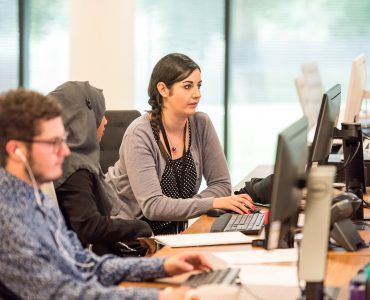How the history of women in IT has evolved, what is happening with human resources in the technology market and where to look for support if you want to become a programmer.
Information technology is one of the most dynamic and promising industries, so it’s no surprise that these days it seems so attractive to anyone, regardless of their gender or age. Besides, world history knows great female programmers.
Among them is Ada Lovelace, the daughter of a poet, who was expected to love literature from childhood, but was interested in mathematics. Growing up, she wrote Bernoulli’s algorithm for calculating numbers and became the world’s first programmer. Betty Holburton worked on the electronic numerical integrator and calculator ENIAC, which became the first general-purpose digital computer. Erna Schneider Hoover gave the world a data processing system with an installed program that allowed the computer to automatically adjust the speed at which telephone calls were received.
Not to be forgotten is Karen Spark Jones, who developed search and retrieval technology that allowed users to work with computers using ordinary words instead of equations and codes. And Radia Perlman, who created the symbolic tree protocol, has been called the mother of the Internet. But all of these examples, from a historical perspective, are rather exceptions. For decades, information technology was considered to be a strictly male domain.
Why is this the case?
According to the 2016 Education at a Glance report, the gender disparity in IT is a result of the education system. The authors of the study concluded: due to social prerequisites, it is mostly boys who go into technical professions, so it turns out that there are more men in the profession. But according to Microsoft study among Russian girls aged 11-18 years old interest in the exact sciences is much higher than in Europe. We have a future profession with the exact sciences link more than 50% of girls, in European countries – only 40%. Of the 29 employees of the Department of High Performance Computing at ITMO University, nine are women, and in two key IT-related metafacultures of the university, about the same third of girls study. Thus, we have a gender gap in IT education, but it can hardly be called grandiose.
At the same time, a study of programmers platform Stack Overflow found that 92% of the developers of the world are men. The number of women in this industry has really been falling in recent years. According to Head Hunter, in Russia there are three women for every ten male IT specialists.
We can connect this fact with a more global phenomenon: in our country only 2% of fathers go on maternity leave. In the vast majority of cases women have to give up building a career and devote themselves to the family – including the fact that men on average receive a third more. A working father brings home more money than a working mother. However, experts say that the situation in our IT-sector is not so deplorable.


















